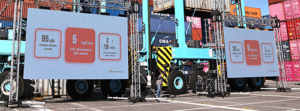Electric straddle carriers have been delivered to the Port of Barcelona, to help APM Terminals meet its target of reducing greenhouse gas emissions.
Electric straddle carriers
In total, five electric straddle carriers will be rolled out in Barcelona as part of APM Terminals’ US$60m global electrification initiative to reduce emissions. According to the company, these carriers will be the first of their kind in the Mediterranean.
“Our celebration today underlines our long-term commitment as a terminal operator to Barcelona and to Spain. The modernization we do here goes hand in hand with our global industry-leading target of net zero by 2040, and Barcelona is a prime example as one of the pilots showing the way with electric equipment. We see a huge potential in further developing our terminals in connection with the overall logistics infrastructure,” said Julián Fernandez, CEO of APM Terminals Spanish Gateways.
The project in Barcelona has been supported by approximately €3m (US$3m) by the Spanish government. Within a year, plans on paper are being transformed to action as the port is getting ready for the first phase of testing. This is being done alongside the setting up of charging stations and implementation of the technology required to operate. 
José Alberto Carbonell, president of Port de Barcelona, said, “The commissioning of the first five electric straddle carriers at APM Terminals Barcelona demonstrates the Port Community’s firm commitment to our decarbonization objectives. I would like to highlight the efforts made by the port’s companies and professionals to efficiently reduce our impact on the environment, and I would like to thank APM Terminals for choosing Barcelona to lead this important global project for the effective decarbonization of maritime port activity.
“The Port of Barcelona is on track to reduce its CO2 emissions by half by 2030 and to be carbon neutral by 2050. To achieve this, we are making progress in the port’s energy transition, with projects such as the Nexigen plan for the electrification of quays, the production of renewable energies, and the promotion of transition fuels and future zero-emission fuels.”
The pilot and equipment testing is being carried out in cooperation with Konecranes and ZPMC.
“Konecranes is proud to partner with APM Terminals Barcelona to contribute to achieving their global industry-leading target with our four battery-powered Konecranes Noell Straddle Carriers and automated charging stations. These innovations support eco-efficient operations and set new standards in decarbonization. Konecranes is driving the shift to sustainable technologies with our Ecolifting ideology, focusing on zero tailpipe emission solutions,” commented Peter Kania, sales director of Konecranes Noell Straddle Carriers.
Barcelona strategy
When APM Terminals kicked off its global pilot program for electrification, Barcelona was one of the five hand-picked terminals to participate. Currently, battery-electric equipment has been piloted in Jordan, Egypt and now Spain. The pilots build a foundation for the next steps: from piloting to implementing the company’s decarbonization strategy with battery-electric at the center.
Sahar Rashidbeigi, head of decarbonization at APM Terminals, stated, “From our operators’ hands-on experiences, it has become evident that some of the upsides – in addition to the lower emissions – are better air quality and working environment, both for our colleagues working with the equipment and for our neighbors around the port area. The feedback we get is that electric equipment provides a quieter and smoother ride and more precise handling. Instant torque makes lifting more effortless, while reduced vibrations and simpler maintenance make for a more comfortable and efficient workday.” 
Pier 400 in Los Angeles is next in line in the pilot program, and the new-build terminals in Rijeka and Suape – starting operations in 2025 and 2026, respectively – are both fully equipped with electric terminal equipment.
“It’s remarkable to think that just 12 months ago, we launched the Zero Emission Port Alliance (ZEPA), and in that time, we’ve completed some crucial work across demand, standardization, and enabling infrastructure. That said, our goal remains to further close the price and performance gap, especially for straddle carriers. Alongside efforts like ZEPA, taking real action – such as this pilot with early-stage assets – is a vital step in that direction,” said Rashidbeigi.
In related news, the Rijeka Gateway terminal in Croatia recently secured electricity from renewable energy sources for the operation of its container terminal to reduce CO2 and other harmful gas emissions. Click here to read the full story.



